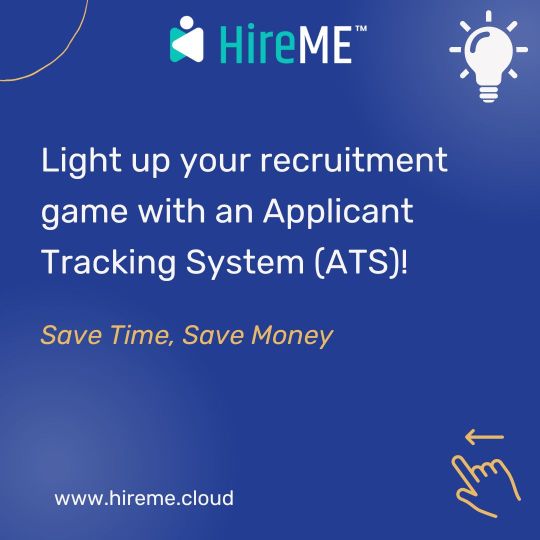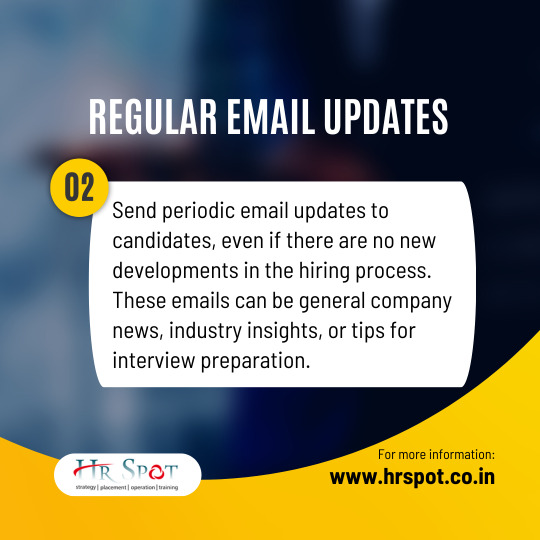#recruitmentprocess
Text

Recruiting and training diverse talent in healthcare is extremely crucial. This article is your go to guide for training healthcare employees from diverse backgrounds. Read the article by clicking on the link https://bit.ly/46fM7TC to learn in depth about the process of recruitment and training employees. #recruitmentprocess #healthcarestaffing #diversityandinclusion #staffingsolutions #staffingandrecruiting
#recruitmentprocess#healthcarestaffing#diversityandinclusion#staffingsolutions#staffingandrecruiting
4 notes
·
View notes
Text
Why You Need to Use a Candidate Confidentiality Agreement in Your Business?
Every business stands on trust, trust reigns supreme. As you navigate the labyrinth of recruitment, sharing sensitive information with potential hires becomes not just a necessity, but a strategic maneuver. Yet, in this era of heightened connectivity and data vulnerability, safeguarding your trade secrets, client data, and strategic plans is paramount. Enter the unsung hero: the Candidate…

View On WordPress
#BusinessProtection#CandidateConfidentiality#CandidateProtection#ConfidentialityAgreement#ConfidentialityClause#ContractTemplate#CorporateSecurity#dataprotection#EmploymentAgreement#HRCompliance#IntellectualProperty#IPRights#LegalCompliance#LegalDocument#NonCompeteClause#NonDisclosure#NonSolicitation#PrivacyAgreement#RecruitmentProcess#TradeSecrets
0 notes
Text








Is traditional recruiting draining your time and money?
Here are 5 reasons why:
Manual resume reviews,
Expensive recruitment processes,
Managing a flood of applicant responses,
Navigating online applications,
Overwhelmed HR departments.
Light up your recruitment game with an Applicant Tracking System (ATS)! Streamline your hiring process, save time, and cut costs. Book your 15-day free trial now: https://www.hireme.cloud/contact-us
#HireME#applicanttrackingsystem#atssoftware#recruitmentsoftware#hr#recruitmentprocess#recruiting#hiring#talent
1 note
·
View note
Text
#FlutterDevelopment#FlutterCommunity#AppDevelopmentServices#TechIndustryInsights#Startups#HireFlutterDevelopers#FlutterDevelopers#AppDevelopment#CrossPlatform#SoftwareDevelopment#HiringDevelopers#RecruitmentProcess#FlutterDeveloperSkills#DeveloperSkills#ITRecruitment#EvaluateTechSkills#MobileAppDevelopers#RecruitingTechExperts#DeveloperHiring#flutter#mobileapp
0 notes
Text
How to Employ Recruitment Technology For Modern Hiring

Businesses today are constantly challenged to find and attract top talent efficiently. The traditional hiring process, with its reliance on manual tasks, paper resumes, and time-consuming procedures, is often inadequate in meeting the demands of the modern workforce. Recognizing these challenges, organizations are turning to technology to revolutionize their recruitment strategies.
The recruitment process, historically viewed as a human-centric venture, is undergoing quite a transformation with the integration of advanced tech. This shift is not merely a luxury for large enterprises; it has become a necessity for organizations of all sizes seeking to remain competitive in the talent acquisition arena.
As the business landscape evolves, so do the expectations and preferences of job seekers. Opting for recruitment technology becomes imperative for organizations aiming to keep up with the pace of change and gain a strategic advantage in securing the best talent available.
By embracing technology in recruitment, organizations can streamline their processes, reduce time-to-fill positions, enhance the overall candidate experience, and make data-driven decisions.
Setting the tone for exploring the evolution of recruitment technology and its diverse applications, this blog talks about everything from Applicant Tracking Systems (ATS) to Artificial Intelligence (AI) in candidate screening to the use of video interviewing platforms.
The use of technology in recruitment is not just a trend but a fundamental shift that promises to redefine how businesses identify, engage, and hire their workforce. Read on to learn how you can leverage technology to transform your hiring processes and meet the dynamic demands of the contemporary workforce.
The Evolution of Recruitment Technology
Recruitment has undergone a significant transformation, evolving from traditional, manual processes to a dynamic and technology-driven one. This evolution is marked by key milestones, reflecting the industry's responsiveness to the changing needs.
Historical Perspective on Recruitment Methods:
Manual Processes: In the not-so-distant past, recruitment heavily relied on manual processes, including paper resumes, physical job postings, and extensive paperwork. This approach was time-consuming, prone to errors, and limited in its ability to reach a vast pool of candidates.
Job Boards and Online Portals: In the mid-1990s, the dot-com boom spawned numerous job websites, providing a digital platform for job seekers and employers to connect. The 2000s saw consolidation and fierce competition for innovative features. Job seekers adapted to evolving resume and search techniques, representing a significant leap forward in terms of accessibility and reach.
Emergence of Technology in the Recruitment Landscape:
Introduction of Applicant Tracking Systems (ATS): The late 1990s and early 2000s saw the emergence of ATS, marking a shift towards more systematic and organized recruitment processes. ATS streamlined resume storage, improved candidate tracking, and introduced a centralized application management system.
Integration of Social Media: The rise of social media platforms in the mid-2000s further revolutionized recruitment. LinkedIn, in particular, became a powerful tool for sourcing talent and connecting with professionals globally.
Key Milestones in the Development of Recruitment Technology:
Rise of Artificial Intelligence (AI): The 2010s witnessed a significant integration of AI in recruitment processes. AI algorithms were employed for resume screening, predictive analytics, and even chatbot interactions to engage with candidates.
Video Interviewing Platforms: With the advent of high-speed internet and advanced video conferencing technologies, video interviewing platforms gained popularity, providing a virtual alternative to traditional face-to-face interviews.
This evolution of recruitment technology reflects a continuous effort to overcome limitations, enhance efficiency, and adapt to the changing dynamics of the job market. The journey from manual processes to sophisticated AI-driven solutions underscores the industry's commitment to staying at the forefront of innovation. This history also sets the stage for understanding the current landscape of recruitment technology and its pivotal role in shaping the future of talent acquisition.
Source to read more about Types of Recruitment Technology: https://ow.ly/TXae50QtfET
Conclusion
The evolution of recruitment technology has reshaped talent acquisition as organizations look to offer efficiency, objectivity, and enhanced candidate experiences. The shift from manual processes to AI-driven solutions signifies a commitment to innovation in the modern job market.
Exela HR Solutions is a leader in streamlining hiring processes. Through advanced technology integration, we offer AI-driven solutions, ensuring efficiency, data-driven decisions, and a seamless candidate experience. Elevate your recruitment strategy with Exela HR Solutions for a future-ready edge in talent acquisition.
Get Exela HR Solutions now!
Contact us for more details: https://ow.ly/Nluj50PICwa
#EvolutionofRecruitmentTechnology#HiringProcess#HRServices#RecruitmentProcess#HROutsourcing#ExelaHRSolutions#RecruitmentProcesses#RecruitmentTechnology#HRSolutions#HR#EHRS#humanresources#hro
0 notes
Text





Once you recruit and hire employees, find out what makes employees stay.
0 notes
Text
Boomerang Hires
Attract Top Talent to Elevate Your Team!
Dive into our newest blog to unravel the strategies behind a successful boomerang hires process. Explore 10 essential steps that ensure the return of proven talent for unparalleled success.
Don't let the opportunity slip away to rebuild your dream team!
Click to read our blog - https://bizessence.com.au/blog/boomerang-hires-bringing-back-proven-talent-for-success/

#bizessence#recruitment#hiringnow#talentacquisition#jobsearch#hrmanagement#jobopening#staffing#humanresources#recruitmentprocess#careeropportunities#jobhunt#hrleadership#jobseekers#employmentopportunities#hrmatters#jobalert#workforcemanagement#hirebetter#blog#article
0 notes
Text
Unlocking career pathways! 🚀 Our recruitment journey in 6 steps: 1. Grasp client needs 🌐 2. Scout talents far & wide 🕵️ 3. Cherry-pick the best 🍒 4. Round 1 interviews to find the perfect match 💬 5. Elevate to the final stage 🌟 6. Seal the deal with a job offer! 🎉
Visit our website : https://marvel-inc.com/
Hurry Up!! Send your Resume to [email protected] or Reach Out to +1(248)-500-7181
#Marveltechnologysolutions#Recruitment#Recruitmentprocess#optjobs#cptjobs#jobsinusa#usa#staffingagency#usitjobs#staffing#cpt#opt#detroit
0 notes
Text
9 Passive Recruiting Strategies To Help Employers Land The Right Candidates

Recruiting - or active recruiting - a commonly practiced approach, sometimes feels like a repetitive game of pong, where recruiters bounce back and forth between a limited pool of candidates actively searching for new opportunities. Breaking free from this cycle and discovering fresh talent with unique perspectives and untapped potential can become challenging. This is where passive recruiting comes into play as a game-changer.
Passive recruiting occurs when you actively seek out candidates who are not actively seeking you. By looking outside the confines of active job seekers and proactively engaging with individuals who may not be actively searching, passive recruitment opens up a vast and untapped pool of candidates. It's like stepping out of the familiar pong game and exploring a whole new playing field. This approach allows recruiters to cast a wider net and attract candidates with exceptional skills and a willingness to consider exciting new opportunities. Moreover, passive recruiting introduces a refreshing element of surprise and discovery, uncovering hidden talents and creating opportunities for individuals who might have been overlooked in the traditional active recruitment process. It expands the horizons of talent acquisition and brings forth a diverse range of candidates who can bring fresh perspectives, innovative ideas, and exceptional value to organizations.
But where do you find such candidates? Well, embracing certain proven strategies such as social media marketing, active participation in relevant communities, promoting your organizational culture and values, and more can indeed help you land the right candidates. Let's explore some of these passive recruiting strategies that will help your organization thrive with a competitive workforce. Dive into the below session to learn more.
9 Passive recruiting strategies to land ideal candidates
Create evergreen social media posts
Using evergreen social media posts on platforms like LinkedIn can yield remarkable results. LinkedIn is widely recognized as a go-to platform for job seekers. Crafting compelling and timeless social media posts with live career links proves to be highly enticing. These posts capture your LinkedIn followers' attention and attract jobseekers to explore the career page. In addition, this approach drives engagement and creates valuable connections within the professional community. Leveraging evergreen social media posts on LinkedIn and other platforms can be a game-changer for organizations looking to expand their talent pool and establish meaningful connections in the industry.
Conduct stay interviews
Prioritizing an exceptional employee experience is paramount in recruitment, allowing you to illustrate your employer branding. And the powerful tool for that is conducting stay interviews with your current employees. Instead of waiting for an employee to resign, take proactive steps to understand how you can enhance their journey within the company. Engage with them during their tenure, seeking their insights on what the company and the leaders should begin, cease, or continue doing. This feedback acts as a catalyst for positive change, enabling you to take actionable steps and demonstrate your commitment to their growth and satisfaction. Stay interview can be leverages as a secret weapon to cultivate a thriving work environment, foster long-term employee loyalty, and get a pulse on your overall employee sentiment.
Hire a candidate sourcing firm
Many organizations traditionally turn to retained or contingency search firms when seeking top-tier passive candidates. However, there is a more streamlined and impactful option available - candidate sourcing companies. These specialized firms offer a highly efficient and cost-effective alternative by connecting companies with interested and qualified candidates. In fact, the services provided by candidate sourcing companies come at a fraction of the cost compared to traditional search firms. By embracing this approach, organizations can enhance their recruitment strategies and tap into a broader range of qualified candidates for their professional-level positions.
Highlight your EVP
Take a moment to reflect on how your organization brings forth positive benefits for its employees. Once you've successfully sourced passive candidates, make it a point to showcase your unique employee value proposition (EVP) during your initial conversation. By doing so, you can effectively draw attention to any areas of dissatisfaction they may be experiencing in their current organization, igniting potential interest in what your company has to offer.
Be active in relevant communities
Motivate your employees to participate in relevant professional associations actively. Extend an offer to speak at or host local chapter meetings to establish valuable connections. Engage with individuals present at these events, regardless of whether you are hiring. You cultivate a "warm" network of relevant professionals by nurturing these relationships. When the time comes to fill openings within your organization, you can tap into this network, leveraging the power of referrals. Even if the individuals are not direct candidates, they will likely have connections who may be a great fit. Proactively building and leveraging a network within professional associations and creating a web of relationships can serve as a valuable resource for your future hiring needs.
Use technology intentionally
Leverage technology strategically while maintaining clear intentions regarding your recruitment goals. LinkedIn and other job portals offer a valuable platform to search for profiles that align with the precise skill set you require. Instead of adopting a generic approach by sending templated messages to numerous candidates, focus on identifying two or three exceptional individuals and reaching out to them personally. Crafting personalized messages demonstrates sincerity and authenticity, which is crucial when engaging with passive candidates. By approaching potential candidates with sincerity and personalized interactions, you can establish meaningful connections and increase the likelihood of capturing the interest of high-quality talent.
Promote the company culture, mission, and impact
A pragmatic strategy for passive recruiting involves strongly emphasizing external communications. This entails leveraging social media platforms to offer glimpses into your company culture, mission, and your organization's positive impact on customers. Additionally, showcasing industry recognition and highlighting workplace benefits further contribute to building a reputable image that resonates with passive candidates. Nurturing your company's reputation among passive candidates through effective external communication channels can yield myriad benefits. By strategically crafting and sharing these messages, you can establish your organization as an attractive and desirable employer, capturing the attention and interest of potential candidates who may not be actively seeking new opportunities.
Offer an internship program
Developing a robust internship program collaborating with local universities can yield significant benefits. By forging strong connections with university staff and offering valuable internship opportunities to their students, employers unlock two distinct avenues for passive recruiting. Firstly, they establish a passive recruiting channel with the university itself, opening doors to engage with alumni and tap into their network. Secondly, as interns complete their program and transition into the workforce, employers have the opportunity to convert these interns into potential passive candidates. By cultivating these connections, employers can foster long-term relationships with students, alumni, and the university community, enhancing their recruiting efforts and ensuring a steady influx of qualified candidates.
Plan an open house
Organize an engaging open house event at your headquarters, allowing candidates to interact with employees, hiring managers, and the recruitment team in a relaxed and informal setting. Such an event aims to foster meaningful conversations within the office environment. The goal is to identify essential competencies, such as curiosity, motivation, intellect, or other valuable characteristics, that can contribute to your company's team. By hosting such an event, you can assess candidates beyond their resumes, tapping into their potential and evaluating their suitability for your team more holistically.
Conclusion
Implementing passive recruiting strategies can be a game-changer for employers seeking to secure the right talent. By casting a wider net and engaging with individuals who may not be actively seeking new opportunities, employers can tap into a vast pool of untapped potential. Numerous effective strategies are available, from leveraging social media platforms and nurturing employer branding to conducting stay interviews and embracing candidate-sourcing companies. The key is to be intentional, genuine, and proactive in building connections and showcasing the unique value proposition of your organization. By adopting these passive recruiting strategies, employers can increase their chances of landing suitable candidates with the necessary skills, mindset, and potential to thrive within their teams. Ultimately, passive recruiting opens doors to a new realm of talent acquisition, enabling employers to find the perfect fit for their organizations and fuel long-term success. Exela HR Solutions specializes in finding, hiring, and onboarding the right talent for your organizational needs. If you are looking to advance your recruitment efforts, get in touch with our experts at Exela HR Solutions today!
DISCLAIMER: The information on this site is for general information purposes only and is not intended to serve as legal advice. Laws governing the subject matter may change quickly, and Exela cannot guarantee that all the information on this site is current or correct. Should you have specific legal questions about any of the information on this site, you should consult with a licensed attorney in your area.
Source & to read more: https://ow.ly/35X250PVvPQ
Contact us for more details: https://ow.ly/FYyy50PxmSI
#PassiveRecruiting#RecruitmentStrategies#RecruitingStrategies#Recruitment#RecruitmentProcessOutsourcing#HRServices#HR#HumanResources#RPO#RecruitmentProcess#HROutsourcing#HRSolutions#ExelaHRSolutions#hro#Recruiting#hiring#recruitment agency#staffing
0 notes
Text
इंडियन नेवी भर्ती 2023 | नौसेना में योग्यता, प्रक्रिया और सूचना
#IndianNavyRecruitment#NavyJobs2023#NavyCareerOpportunities#QualificationRequirements#RecruitmentProcess#JoinIndianNavy#NavyVacancies#NavyNotification#JobSeekers#NavyInformation#User#make 5 title from this: स्टाफ नर्स रिक्रूटमेंट 2023#ChatGPT
0 notes
Text

Need a reliable workforce for your upcoming project?🛠️💪
Let us assist you in creating a competent team!
Efficiency, reliability, and expertise - that's what Euro Emirates LLC brings to your labour supply needs in the UAE!
Our workforce comprises diverse skill sets & committed to ensuring value addition to each project. We handpick the skilled staff through our streamlined recruitment process & appoint them to proper positions.🌟💼
So, elevate your workforce with us and experience the difference!🚀🌍
Browse https://www.euroemirates.com/ for more details.
0 notes
Text
How Do Intelligence Agencies Recruit Spies: Unveiling the Intricate Process

Espionage has always captured the imagination of many, largely thanks to the enigmatic allure of secret agents and covert operations.
We've been exposed to countless spy thrillers in literature, film, and television, but how close are these portrayals to the reality of how intelligence agencies recruit spies?
In this blog, we'll delve deep into the intriguing world of espionage recruitment, uncovering the methods, strategies, and challenges that intelligence agencies face in their pursuit of information.
Understanding the Basics of Espionage
Espionage is the art of gathering classified or sensitive information from a target, often an enemy or rival state, without their knowledge or consent.
This practice has existed for centuries, and it plays a crucial role in national security and international affairs.
To carry out successful espionage operations, intelligence agencies need individuals willing to risk their lives and assume false identities to infiltrate targeted organizations or countries. These individuals are commonly known as spies, agents, or assets.
The Overt and Covert Recruitment Process
Intelligence agencies use a combination of overt and covert methods to recruit spies.
The overt methods involve approaching potential recruits openly and legally, often seeking individuals with access to valuable information.
These individuals may include diplomats, military personnel, government officials, or scientists.
Overt recruitment typically occurs through diplomatic channels or during international conferences and meetings.
However, covert recruitment is where the intrigue deepens.
Covert recruitment involves identifying individuals who can provide access to critical intelligence, often from within the enemy's ranks or other sensitive environments.
This process is carried out discreetly and sometimes involves persuading individuals to betray their loyalty to their own country.
Identifying the Right Candidates
Choosing the right candidates to become spies is a meticulous and resource-intensive process. Intelligence agencies seek individuals with specific attributes, such as:
Access to Information: The most critical factor in recruitment is an individual's access to valuable intelligence. This could be military officers with knowledge of classified operations, scientists with access to research data, or diplomats privy to sensitive negotiations.
Motivation: Spies are often motivated by various factors, including financial gain, ideological beliefs, or personal grievances. Intelligence agencies identify what motivates a potential spy and use this as leverage.
Reliability: Trust is paramount in espionage. Agencies assess a candidate's trustworthiness through extensive background checks and interviews. They look for individuals who can maintain secrecy and handle the pressure of covert operations.
Cultural Fit: Spies often need to blend into their target environments seamlessly. This means considering factors like language skills, cultural knowledge, and the ability to assume a new identity convincingly.
Blackmail or Coercion: In some cases, intelligence agencies may identify vulnerable individuals who can be coerced or blackmailed into espionage activities. This can be a last resort when other methods fail.
The Recruitment Pitch
Once a potential candidate is identified, intelligence agencies carefully craft a recruitment pitch tailored to the individual's motivations and vulnerabilities.
This pitch may involve financial incentives, promises of asylum, or even threats to reveal compromising information.
The goal is to persuade the candidate to cooperate and start providing valuable information.
The Spy's Training and Cover Story
Once recruited, spies undergo extensive training to prepare for their roles.
They learn tradecraft skills such as encryption, communication methods, evasion tactics, and surveillance detection.
Additionally, they assume cover identities and personas that will help them infiltrate their target environments without arousing suspicion.
The High Stakes of Espionage
It's important to note that espionage is not without risks. Spies often operate in dangerous situations, and the consequences of being exposed can range from imprisonment to execution.
This high-stakes environment is one of the reasons intelligence agencies go to great lengths to protect their assets and ensure their safety.
Conclusion
The recruitment of spies by intelligence agencies is a multifaceted process that combines elements of psychology, tradecraft, and geopolitics.
It is a high-stakes endeavor that requires careful planning, resource allocation, and, above all, the ability to persuade individuals to betray their own loyalties for the greater good (as defined by their handlers).
Understanding this recruitment process provides a fascinating glimpse into the world of espionage, where secrecy and deception are the norm, and the consequences of failure can be dire.
#SpyRecruitment#IntelligenceAgencies#CovertOperations#SpyCraft#RecruitmentProcess#UndercoverAgents#EspionageNetworks#SecretService#SpyTraining#NationalSecurity
1 note
·
View note
Text









Building a successful team relies on an efficient recruitment process. From understanding organizational needs to effective onboarding, each stage of recruitment plays a vital role in hiring top talent.
Are you ready to optimize your recruitment journey and hire top talent for your dream team? Introducing HireME ATS: the ultimate solution to simplify every aspect of hiring. Start your 15-day free trial now and transform your recruitment process effortlessly: https://www.hireme.cloud/contact-us
#HireME#applicanttrackingsystem#atssoftware#recruitment#hiringprocess#recruiting#recruitmentprocess#hiring
1 note
·
View note
Text

Effective recruitment is essential for building a high-performing team. Our solutions provide you with the tools and insights you need to evaluate your team's performance and make strategic hiring decisions.
.
#hiring#recruitment#building#team#hrdunia#teamperformance#recruitmentprocess#hiringprocess#topnotchrecruitment
1 note
·
View note
Text
How to Create an HR Strategy That Aligns With Your Business Goals

Picture this: HR as your strategic ally, not just dealing with day-to-day workforce needs but seamlessly syncing with the big-picture goals of your business. In today's fast-paced and competitive business world, the role of Human Resources (HR) has transformed from mere administrative tasks into a key player in driving organizational success.
So, what exactly is HR strategy? It's the game plan, the well-thought-out approach an organization adopts to manage its human capital for that sustainable competitive edge. Think of it as the secret sauce that aligns HR practices with broader business goals, creating a powerful synergy that propels the entire organization forward. No longer are employees just resources to be managed; they're the driving force behind innovation, productivity, and success.
Aligning HR with business goals is of utmost importance and should not be underestimated. When HR strategies are closely integrated with the organization's overarching objectives, it fosters a harmonious relationship between the workforce and the company's mission. This alignment ensures that every HR initiative contributes directly to the business's success, creating a more efficient and effective working environment.
An effective HR strategy goes beyond routine personnel management tasks. It serves as a compass, guiding the organization through talent acquisition, development, and retention complexities.
As we delve deeper into the intricacies of creating an effective HR strategy, it becomes evident that this strategic approach is not a one-size-fits-all solution. Instead, it requires a tailored and nuanced understanding of both the specific business goals and the unique characteristics of the workforce.
Components of an Effective HR Strategy
Recruitment and Talent Acquisition
Attracting and Retaining Premier Talent: Organizations strive to attract and retain top-tier talent in a competitive global market. HR strategies should focus on employer branding, creating an appealing workplace culture, and utilizing innovative recruitment techniques. Retaining talent involves competitive compensation and providing a work environment that nurtures professional growth and development.
Aligning Skills with Business Needs: Successful HR strategies involve a proactive approach to understanding the skills required to meet current and future business objectives. HR professionals should collaborate closely with department heads to identify skill gaps, plan for succession, and ensure that the workforce possesses the competencies needed to drive the organization forward.
Employee Development and Training
Promoting Continuous Learning: In rapidly evolving industries, continuous learning is essential. HR strategies should encompass initiatives such as training programs, workshops, and online courses to upskill and reskill employees. This enhances individual performance and ensures that the workforce remains adaptable and capable of meeting changing business demands.
Skill Development for Future Business Requirements: Anticipating future business needs, HR must focus on developing skills that align with emerging trends. Whether it's technological advancements, industry shifts, or new market demands, HR strategies should include long-term skill development plans to keep the workforce ahead of the curve.
Performance Management
Defining Performance Expectations: Transparent communication of performance expectations is crucial. HR strategies should involve establishing clear, measurable goals aligned with broader business objectives. This clarity ensures that employees understand how their individual contributions contribute to the organization's overall success.
Aligning Individual Goals with Organizational Goals: HR should facilitate a performance management system that aligns individual goals with organizational goals. This alignment ensures a cohesive effort across all levels of the organization and reinforces the connection between individual achievements and the collective success of the business.
Employee Engagement and Retention
Building a Positive Workplace Culture: HR strategies play a pivotal role in shaping and maintaining a positive workplace culture. This involves fostering a sense of belonging, emphasizing diversity and inclusion, and promoting open communication. A positive culture contributes to higher employee morale, engagement, and a shared commitment to achieving business goals.
Employee Satisfaction and Retention Strategies: HR should implement strategies to gauge employee satisfaction and identify factors contributing to retention. This might include regular employee surveys, feedback mechanisms, and initiatives such as flexible work arrangements, recognition programs, and career development opportunities.
Source to read more about Strategies to Align HR with Business Goals: https://ow.ly/N9po50Qsr7c
Conclusion
A business can never overstate the importance of aligning human resources (HR) with business goals; it serves as a crucial driver for organizational success. An effective HR strategy, seamlessly integrated with overarching business objectives, is key to optimizing talent management and fostering a resilient workplace culture.
The takeaways emphasize strategic integration, continuous adaptation, and data-driven decision-making as fundamental principles for success. Encouraging organizations to invest in strategic HR practices underscores the importance of prioritizing alignment to enhance competitiveness and create an environment conducive to employee growth.
For those seeking a partner in this journey, Exela HR Solutions stands out, offering tailored and adaptable HR solutions that leverage cutting-edge technologies and data-driven insights for sustained success.
Contact us for more details: https://ow.ly/Nluj50PICwa
#MasteringPersonalizedRecruitment#RecruitmentProcess#HRServices#RecruitmentStrategies#ExelaHRSolutions#Recruitment#HRSolutions#BusinessSuccess#HROutsourcing#PersonalizedRecruitment#EHRS#hr#humanresources#hro
0 notes
Text
"An employer brand is an intangible. However, many tangible practices and behaviours contribute to it.”
Employer branding is practical as a set of processes, it starts with the very first contact of a potential candidate with your brand and flows continuously through every step of the so-called Talent journey. It includes the data behind the recruitment and selection process, keeping the talent happy, engaged and loyal to your organisation, and also reflects in how willingly your employees recommend working at your company to others.
0 notes